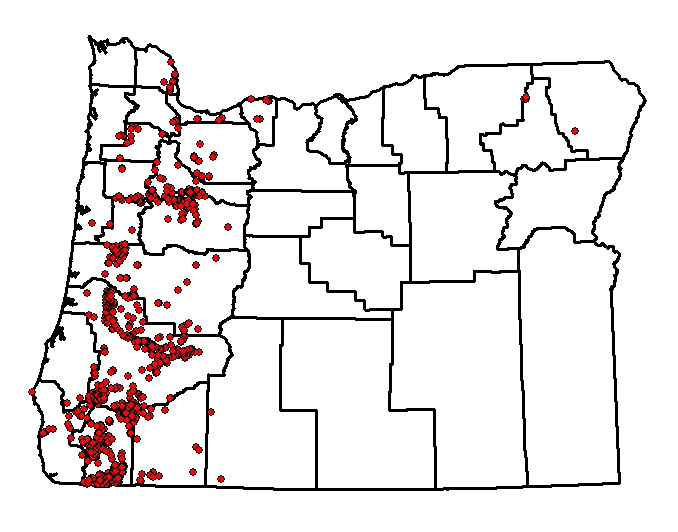Meadow knapweed (Centaurea moncktonii) is a hybrid between two European knapweed species: black knapweed (Centaurea nigra), which is native to the British Isles and brown knapweed (Centaurea jacea) which is native to continental Europe. Both parent species are sold as flower seeds in the United States and Europe. Whether meadow knapweed was originally introduced as a hybrid or formed in the United States from escaped ornamentals is not known. Both parents and the hybrid offspring are tetraploid, possessing forty-four chromosomes. The hybrids backcross with either parent and form highly variable populations whose individuals may closely resemble either parent.
The earliest records of meadow knapweed in Oregon are from Multnomah and Lane Counties between 1910 and 1920. Relatively more palatable to livestock than other knapweed species, it was reported to have been planted as a potential forage species near Roseburg (Douglas County) around 1959. This is the only example of a knapweed being intentionally planted for forage. In Oregon it is classed as a Class B noxious weed; the policy is for containment in regions where it is widespread and for elimination elsewhere.
Most of the meadow knapweed in Oregon grows west of the Cascade Range, with the largest populations in Douglas, Josephine, and Jackson Counties, extending north into the Willamette Valley. In all, it has been found in twenty Oregon counties.
Meadow knapweed is a perennial, with several upright stems that grow from a woody crown. Leaf margins are entire, lobed, or toothed. The rose-purple flowers (occasionally white) are clustered in round heads about the size of a nickel. Flowering peaks in July and August, but occasional flowers can be found west of the Cascade Mountains into November and December, particularly on plants that have been grazed or mowed. Bracts surrounding the flower heads are light to dark brown, with a papery fringed margin. At the time of flowering, the bracts reflect a metallic golden sheen.
Meadow knapweed is a weed because it escaped cultivation, has low palatability to cattle, and invades native plant communities. Moist sites appear most susceptible to invasion: irrigated pastures and mesic meadows, bottomlands along rivers, the wet margins of streams and irrigation ditches, and forest clearings.
It reproduces primarily by seed, but root and crown fragments re-sprout when broken apart by heavy equipment or cultivation. Meadow knapweed seeds are carried in rivers, streams, or irrigation water, in hay, or by vehicles along roadsides. Some people find it attractive and plant it as a garden ornamental. As is common among knapweeds, it produces both pollen and nectar, making it a desirable plant to beekeepers. It can be used as forage for sheep and goats because the green plants have good nutritional quality. However, invading infestations in new areas should be controlled promptly to prevent its spread.
-
![Meadow knapweed.]()
Meadow knapweed..
Meadow knapweed. Photo Cindy Roche, courtesy Bugwood.org. Item Number 1350053
-
![Meadow knapweed.]()
Meadow knapweed..
Meadow knapweed. Photo Eric Coombs, Oregon Department of Agriculture, courtesy Bugwood.org. Item Number 0021042
-
Distribution map of meadow knapweed, data submitted through 2010..
Distribution map of meadow knapweed, data submitted through 2010. Courtesy www.weedmapper.org
-
![Meadow knapweed.]()
Meadow knapweed..
Meadow knapweed. Photo Cindy Roche, courtesy Bugwood.org. Item Number 1350052
Further Reading
Marsden-Jones, E.M., and W.B. Turrill. British Knapweeds: a study in synthetic taxonomy. London: The Ray Society, 1954.
Susanna, A., and C. Roche. "Unlikely pairing of two alien species in Oregon produces unwanted offspring." Kalmiopsis 18 (2011): 24-29.




